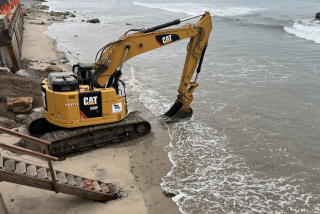Escondido, Developer Under Investigation : Inquiry: Possible environmental violations at the Lomas del Lago development near Lake Hodges are focus of San Diego County district attorney’s office.
It was last New Year’s Eve when Fred Ferrazzano lost his cool and demanded that state Fish and Game Department officials stop developers from burying his stream.
“That was the day that the bulldozers moved over on my property and started building a dam,” Ferrazzano said. “I’m not against development, but I am against raping the land.”
Ferrazzano’s complaints against developers of the immense Lomas del Lago development flanking Interstate 15 in southern Escondido are now being investigated by the San Diego County district attorney’s office. The district attorney could file civil or criminal charges against the developers--a consortium of companies known as the Lomas Development Group--Escondido city officials and the developer’s engineering firm, Regional Environmental Consultants.
Jim Pitts, deputy district attorney in charge of the investigation, said state Fish and Game officials turned the matter over to his office Friday, recommending that the city of Escondido be charged criminally in the matter.
Ferrazzano, who developed a 20-acre tract next to the Lomas del Lago properties, said he has been trying to get someone to stop the developers from converting an unnamed stream through the subdivision into a buried pipeline. Altering a stream, he said, violates both federal and state environmental regulations that call for preservation of riparian habitat and requires permits and mitigation.
The city of Escondido is involved because it purchased the Lomas del Lago land from the city of San Diego and sold it to the developer in 1988, in return for obtaining a 130-acre public golf course for the city.
Ferrazzano has been protesting the situation to city, state and federal politicians and agencies for more than three years. He was required to obtain permits to develop his 10-acre property east of the freeway and to set aside more than 3 acres of land along the stream, he said, “and yet these guys just went ahead and did what they wanted.”
When Lomas developers brought in bulldozers and began to convert the stream bed into a buried culvert, he redoubled his efforts. Then, last December, Ferrazzano finally got results. The state Fish and Game Department ordered Lomas developers to stop work on the western portion of the land when they attempted to build a dam on Ferrazzano’s property.
Pitts said he has “just begun what will be a very lengthy investigation into the matter.” A state Fish and Game report recommends criminal action against the city of Escondido because of an agreement with the developer that commits the city to monitor the project and assist in obtaining necessary permits, he said.
The attorney said civil or criminal sanctions may also be lodged against the developers and their engineers for not reporting the presence of stream beds through the property and for destruction of existing stream habitat.
Escondido Mayor Jerry Harmon, the only member of the present City Council who was in office when the city purchased the land and sold it to the Lomas del Lago developers, could not be reached for comment Tuesday.
Rod Wood, a former Escondido assistant city manager who had been in charge of the city-developer agreement, also was unavailable because he was on his way to a meeting in Monterey.
Harmon opposed the Lomas del Lago development in 1988, arguing that too many housing units were being allowed on the 279-acre property. In 1989, the agreement was renegotiated to allow less dense development.
Ferrazzano said he will meet with Pitts later this week to show him documentation he has accumulated during his fight to prevent destruction of his stream and to show him where “half a million cubic yards (of dirt) have been dumped on what used to be a natural stream.”
He estimates that 10 to 12 acres of wildlife habitat along the stream bed has been destroyed, and he wants to see the developer ordered to restore the land to its natural state.
“I want the stream put back,” Ferrazzano said. “I know that it will cost them 5 to 10 million dollars to do it, but it will send a message to other developers that they can’t get away with this.
“Conscientious developers are caught in the middle. They can’t compete. I think the government should make the penalty fit the crime.”
More to Read
Sign up for Essential California
The most important California stories and recommendations in your inbox every morning.
You may occasionally receive promotional content from the Los Angeles Times.










